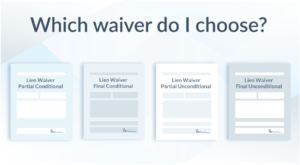

Everyone in the construction industry encounters lien waiver documents, but too often, these complex and consequential forms are overlooked. Whether you’re a sole proprietor or a large corporation, understanding and managing construction lien waiver requests is important.
This comprehensive article will explain everything you need to know about lien waivers and walk you through best practices that could save your construction business from a very expensive mistake.
Table of Contents
A lien waiver is a document signed in exchange for payment that waives the signer’s right to file a lien for the amount specified in the waiver. You can think of lien waivers as the construction industry’s version of a receipt for payment.
On most projects, the GC requests, collects, and tracks lien waivers from everyone on the job when they are paid. This includes contractors, subcontractors, material suppliers, equipment rental companies, and any other party (potential lien claimant) to the construction project. Signing a waiver waives lien rights to the extent (the amount of money) set forth in the waiver.

Need a Lien Waiver?
Create lien waivers in minutes for free. Send a signed waiver to your customer, or request a signature from vendors.
Anyone furnishing materials, labor, or services to a construction project may be entitled to file a mechanics lien or bond claim in the event that they are not paid. But at the same time, those in charge or at “the top” of a project — such as the property owner, lender, construction manager, or general contractor — are highly motivated to finish the project successfully without any liens or bond claims being filed.
And that’s where waivers come in. Waivers serve as a sort of “proof of payment.” Every time a payment is made on a construction project, there is a payor (the paying party) and a payee (the party receiving payment). When lien waivers are involved, the payee will execute (sign) a lien waiver acknowledging receipt of the payment, and promising to not file a lien with respect to the same amount. They payor (typically, the GC) will collect and track all of the lien waivers from the subs and suppliers on the job, and submit them to the property owner.
When this system works as it should, everyone should walk away happy: The payee gets paid the money they’ve earned, and the paying party gets the assurance that there won’t be a mechanics lien filing. For these reasons, sending lien waivers can actually help you get paid faster.
Why are lien waivers necessary?Lien waivers serve as a sort of “proof of payment.” Every time a payment is made on a construction project, there is a payor (the paying party) and a payee (the party receiving payment). When lien waivers are involved, the payee will execute (sign) a lien waiver acknowledging receipt of the payment, and promising to not file a lien with respect to the same amount. They payor (typically, the GC) will collect and track all of the lien waivers from the subs and suppliers on the job, and submit them to the property owner.
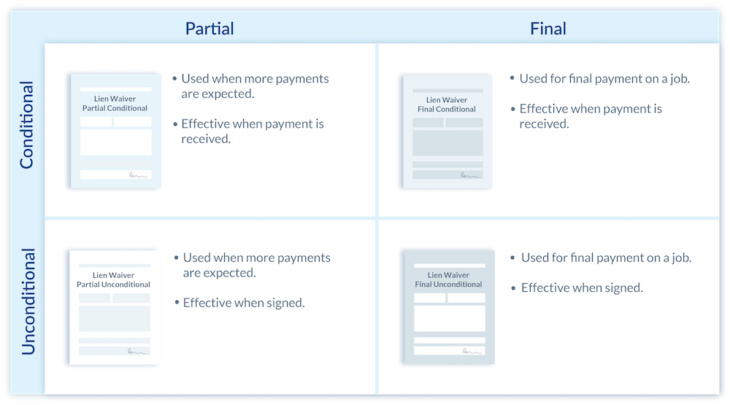
Here’s a big problem about lien waivers — the waiver terminology used is not standardized across the construction industry. Depending on where you work or whom you work with, you may hear folks calling lien waivers by another name, such as “lien release” or “waiver of lien” and many others. California’s lien waiver laws actually refer to it as a “Waiver and Release.”
This can get confusing, especially since a lien release is an entirely different document from a lien waiver. While a lien waiver is used to prevent mechanics liens, a lien release is used to cancel a lien after it has been filed. (It’s also known as a lien cancellation.)
Not surprisingly, the terminology used by the industry to describe a lien cancellation is also very haphazard. You might also hear “lien removal” or “lien release” and several others. All in all, this problem with confusing terminology can have serious consequences, so be clear about which document you’re referring to!
Unfortunately, the naming confusion does not end there. Another confusing concept in the world of construction payment is “no lien clauses.”
No lien clauses (also called “no lien agreements”) are provisions in a construction agreement whereby a party agrees to waive any future lien claims. Since the contract is typically signed at the very beginning of a project before the work actually begins, this means that a “no lien clause” comes into play before any payment is due and/or before any furnishing.
A no lien clause is different from a lien waiver. A waiver comes after the work has been performed and is only signed by parties after a payment is due, wherein the party waives the right to file a lien for the work that is being paid for.
Unlike the lien waiver document, no lien clauses are very controversial. In fact, they are only formally allowed in just 2 states. No lien clauses are expressly outlawed by the legislatures in over 20 states.
Now that you know some lien waiver background information, it’s time to turn to the instrument itself. This where lien waiver management gets enormously confusing. While a few states create mandatory lien waiver forms, the majority of states do not, which leaves the parties to grapple about what these documents should and should not say.
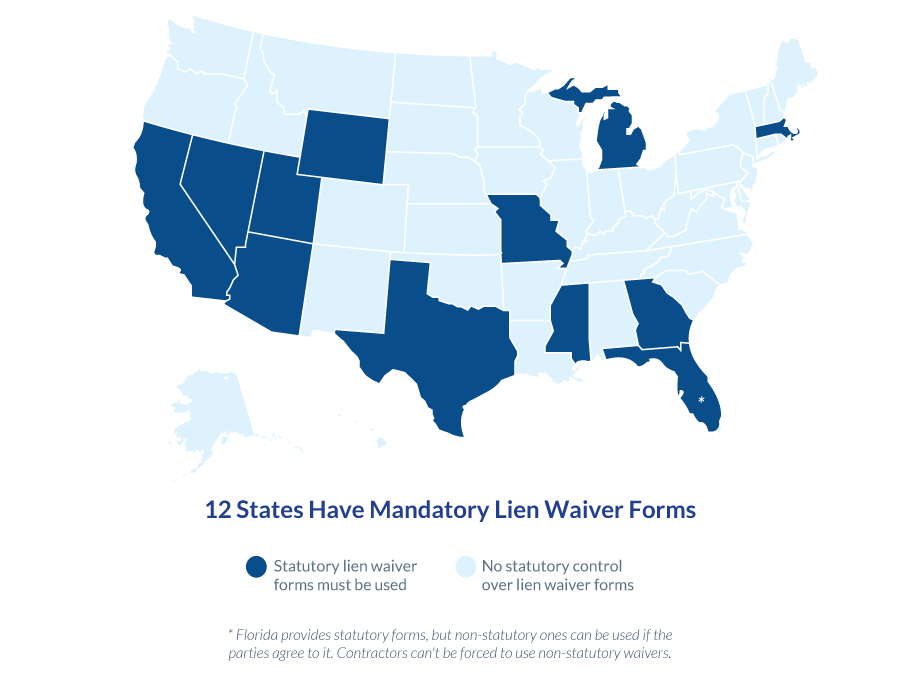
| States with Statutory Lien Waiver Forms | |
|---|---|
| Arizona Waiver FAQs | Mississippi Waiver FAQs |
| California Waiver FAQs | Missouri Waiver FAQs |
| Florida Waiver FAQs* | Nevada Waiver FAQs |
| Georgia Waiver FAQs | Texas Waiver FAQs |
| Massachusetts Waiver FAQs | Utah Waiver FAQs |
| Michigan Waiver FAQs | Wyoming Waiver FAQs |
*Florida does not require that parties use the statutory lien waiver, but it offers the waiver as a safe option, and seems to prohibit parties from requiring a non-statutory form.
If you are furnishing materials, labor or services to one of the 12 “regulated” states, dealing with lien waivers is a little easier. If the time is right to sign a lien waiver, you simply serve up the statutory form and submit it. There is no room for debate about the contents of the lien waiver document because the state legislatures typically render any non-statutory lien waiver forms as completely null and void.
If working on a construction project in one of these three states, then notarization in order for a lien waiver to be considered valid and enforceable.
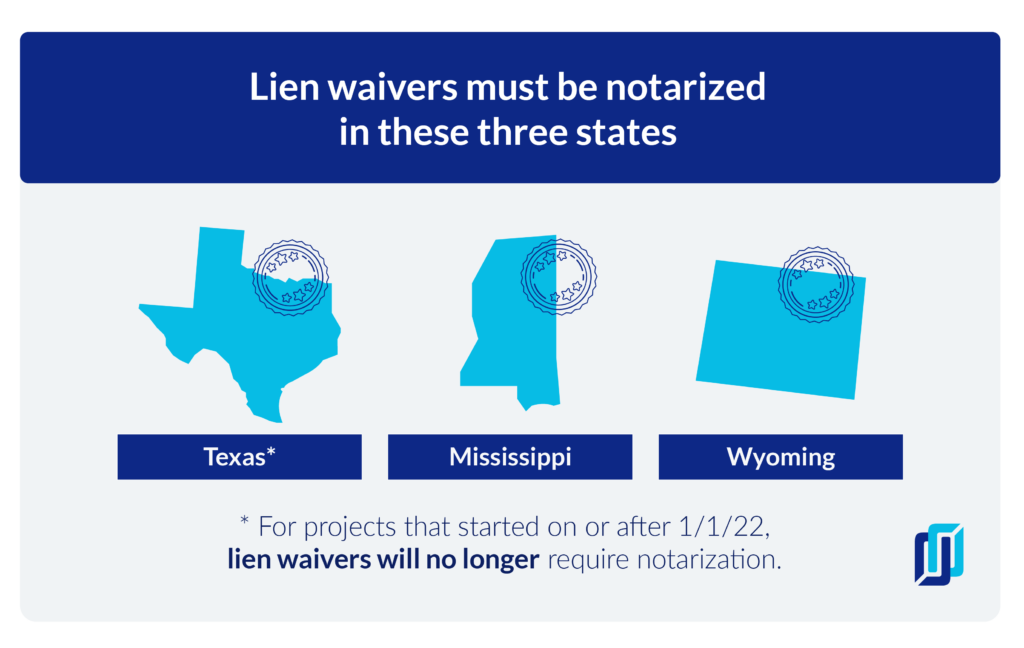
Additionally, it’s important to note that notarization in other states could negatively impact the lien waiver’s validity. If working in one of the 12 states that provide statutory lien waivers, the statutes typically state that the lien waiver must be “in substantially the same form” as the one provided. Courts in those states tend to enforce this requirement rather strictly.
Meaning that any alterations, including notarization, could materially change the form, thereby invalidating it.

Texas rules for mechanics liens and notices are subject to major changes in 2022.
The information on this page has already been updated to reflect the new rules.
Because 38 states do not have statutory requirements for lien waiver forms, they allow the forms to appear in basically whatever form the parties want. This can create confusion and allow lien waivers to be used as a document to craft a legal position. While this isn’t the intended purpose of lien waivers, it is something that a vigilant party should be on the lookout for.
Below are 3 examples of potentially troublesome waiver language that you need to be wary of.
Managing lien waivers on projects where there is retainage, change orders, and “extra work” can be a huge challenge.
“Retainage creates a tricky issue” in lien waivers, explains David Eisenberg. “Because the lien waiver is supposed to waive lien rights to all work performed up to the effective date…[if] an owner is withholding retainage, contractors risk waiving their lien rights if they submit unconditional lien waivers.”
This is yet another reason why unconditional waivers are dangerous to use!
The same “tricky issue” is present with a few other token construction contract issues like unapproved or pending change orders and extra work.
Subcontractors are typically required to submit their pay requests through a pay application, and that pay application includes certain work items and excludes certain work items. The trouble with many lien waivers is the language frequently waives “everything” up to a certain date, irrespective of what may be excluded by the pay application (i.e. retainage, pending change orders, etc.).
Subcontractors must be very, very careful with this.
California’s statutory lien waiver forms handle this issue fairly well. Each of its waivers contains a section labeled “Exceptions,” where the subcontractor can stash any number of excepted items, and the progress waivers include statutory exception text excluding retainage and unpaid “extra” work. It’s still important that subcontractors keep their head up, notice this exceptions section, and accurately complete it.
Further reading:
Starting up on a new construction job includes many activities. There’s the RFP, the estimating process, submitting your bid, and so on. If your company is chosen to work on the job, at some point before the work commences, you’ll probably sign a contract. That contract will spell out all of your agreed-upon responsibilities (what you have to do), and also, all of your agreed-upon “rights” as spelled out in the contract (what you get).
Regarding lien waivers, the danger here is that your construction contract says you’re allowed a certain right, but then you sign a lien waiver that includes language stating that you a “waiving” or giving up that right.
There’s an infamous case out of Texas involving a company called Zachry Construction that illustrates the danger here. In that case, Zachry ended up losing over $2 million because the waivers they signed prohibited them from defending themselves against liquidated damages.
Take a moment to think about how scary this scenario can be:
Zachry Construction did work and was owed money for it. To receive a payment, they were required to sign lien waivers. The exchange of lien waiver for payment is completely fair, and a sensible and traditional thing for both parties to do. However, the parties also had some things they disputed aside from the exchanged payment (i.e. liquidated damages). The lien waiver document, which really has nothing to do with the dispute, disarmed Zachry completely because it had provisions within it waiving the rights to assert any defenses.
Unfortunately for Zachry, the lien waivers they signed included provisions that waived a lot more than lien rights, and it ended up costing them millions of dollars.
Bottom line: Be careful that the waivers you’re signing in order to get paid do not include any extra language that causes you to give up contractual rights!
Another thing we’ve seen in lien waivers is a requirement that the person signing the waiver “personally attest” to the contents of the waiver. This personal attestation requirement may seem benign at first glance, but in reality, it creates potential personal liability on a construction contract that likely does not have any personal liability otherwise.
Obviously, a subcontractor or an employee at the subcontractor’s office will want to avoid this risk.
Learn about when to sign a waiver:
Let’s say you were paid $50,000, but your lien waiver says you were paid $100,000.
There are two possible explanations for this. Perhaps, first, you made a mistake and the waiver amount is simply an accident. Or perhaps, second, the lien waiver amount was requested by the owner and general with the promise to pay you the full amount later.
The trouble with lien waivers is that the law probably doesn’t care about these explanations at all. In most states, the courts will look to the waiver itself, and if it says $100,000, that’s the final authority on the matter. You were legally just paid the $100,000.
State legislatures and courts are constantly balancing the rights of owners against the rights of potential lien claimants, and the whole point of the lien waiver is to protect third parties against unknown liens. If the third party does their job of collecting the lien waivers, then the courts and statutes must protect them in the event the waivers are inaccurate through no fault of their own. In large part, that is exactly what happens.
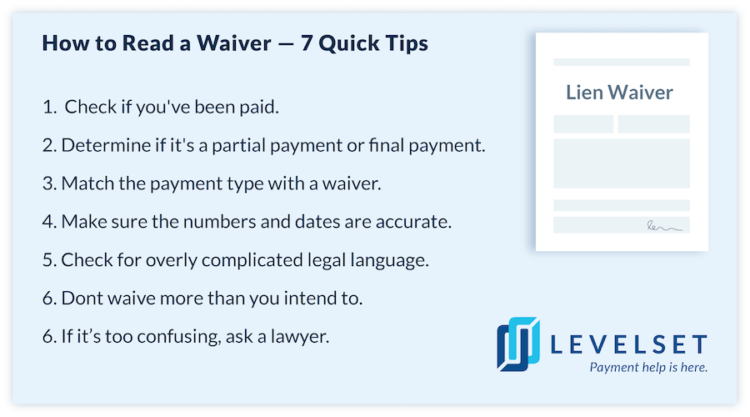
Essential Reading:
It should now be clear that lien waiver documents are complicated and largely unregulated, and that their consequences could be severe. It’s surprising, therefore, how infrequently companies employ formal policies controlling how lien waivers are processed and managed. Too often, companies simply enable their staff to exchange lien waivers for payments willy-nilly, blind to the hidden dangers that may be lurking in the details of a lien waiver form.
Just like your company relies on policies and procedures to dictate who can receive trade credit, and how debts can be collected, and even how liens and bond claims must be managed, so too should your company rely on a written policy and procedure to manage how lien waiver requests are received and handled.
Here are the three things that you must achieve with your lien waiver policy:
Identify the states where statutory forms are used and provide a place for those forms to be referenced. For all other states, establish an accepted, standardized form that can be used for lien waivers. This enables you to save time with a default waiver template.
When are lien waivers provided/requested? Who is authorized to review waivers that differ from the default template? Who is authorized to approve them? How are those processes managed?
A road map is required to give every lien waiver request consistent treatment.
The quick and easy exchange and management of documents is the biggest obstacle to changing waivers from vehicles of fear and friction to the documents that free projects from those concerns. Using lien waiver software can help make the lien waiver exchange process easier and simpler for everyone.
The ability of construction participants to a) “automatically” (whether by a manual process or true automation) send sufficient and appropriate lien waivers prior to request, and b) have a system to receive and manage the documents received takes the frustration out of the process and leads to good results.
This is impossible to do without the use of proper tools, though. The ability to request lien waivers, to accept lien waivers in any form (but primarily electronically), and have all waivers available in one place to be viewed and managed is a life-changer. And the ability to send waivers without worry regarding the waiver form or template or fear over whether additional rights are being waived or additional obligations imposed is crucial.
Interested in using some tools to help your lien waiver process but not sure of which one? Take a look at our guide to the Best Lien Waiver Software Apps, including ratings & reviews.
Use the following links to download the lien waiver forms you need.

Lien Waivers are a critical tool for construction payment. This article explains all you need to know about lien waivers with free waiver form downloads.